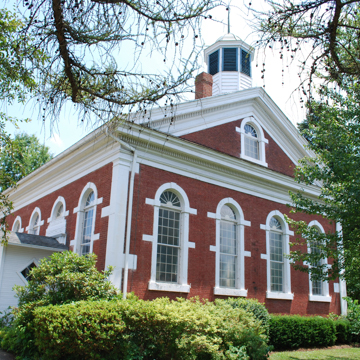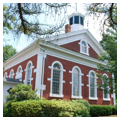The Village of Zoar is a small residential community in Tuscarawas County in northeastern Ohio, about fifteen miles south of Canton and nine miles north of New Philadelphia, the county seat. Zoar was the only permanent U.S. home of the Society of Separatists of Zoar, a religious communal utopian society that prospered in the middle of the nineteenth century. Zoar was founded during the early nineteenth century, a period that witnessed an explosion in the establishment of religious and secular utopias and communal societies. Zoar was one of several religious societies to have originated in Germany. With the exception of the Shakers, these German societies endured the longest and they exerted the most significant influence on American utopian societies overall; indeed, Zoar was one of the most successful and influential.
Persecuted in Germany, a group of roughly 300 Pietistic separatists fled their homeland in 1817 for the religious freedom of the United States. The immigrants settled in Ohio and quickly established a community, which they named Zoar. Calling themselves the Society of Separatists of Zoar (they were also known as Zoarites), the group did not come to America with the intention of living communally, but they did want to live as a group, worshiping freely and separate from outside influences. After two years of struggling to sustain their fledgling settlement, repay their debts, and care for its elderly and infirm population, the Zoarites decided that communal living was the best solution for their survival. In April 1819, the men and women of Zoar signed the Articles of Association, renouncing their right to property ownership and agreeing to live by society regulations. The Separatists owned their land, buildings, agricultural businesses, commercial enterprises, industrial concerns, church, and school collectively. There was a central bakery and dairy, where members collected bread and milk. At the sewing house, members manufactured the majority of the Zoarites’ clothing. Under the able leadership of Joseph Bimeler, the community prospered, and upon Bimeler’s death in 1853, the society’s holdings were valued at more than a million dollars.
The settlement created by the Society of Separatists of Zoar in 1817 was distinctive: a German village established in the middle of rural Ohio, with separate customs, traditions, religious beliefs, and its own architecture and landscape. Throughout Zoar, the buildings display traditional Germanic architectural features and construction practices, and medieval agricultural landscape patterns. The Zoarites’ goal was to exist as a unified group and even after they were settled they had no interest in assimilating into the broader society. Retaining their native architectural traditions was a deliberate decision, one that allowed them to maintain their culture. German immigrants had been utilizing their traditional building forms and construction methods in America since the late 1600s, including steep-pitched roofs often with two-story attics, limited fenestration, massive internal fireplaces, paling insulation, tile roofs, vaulted cellars, and half-timbering. All of these Germanic architectural features are evident in Zoar, along with hewn log construction, cupolas, and brick and stone nogging. Of particular note in Zoar are the tile roofs, Dutch biscuits, half-timbering, and vaulted stone cellars. While these features offered Zoarites a connection to the Old World, they gave the village a quaintness that visitors marveled over in the nineteenth century.
As in their buildings, Zoarites deliberately maintained their traditional agricultural landscape. The village was platted so that the inhabitants resided within the village proper, leaving the center to work in the surrounding farm fields. This reflects a medieval agricultural-village arrangement known as Landschaft. Although this open field configuration differed from the typical individual farmsteads the Zoarites observed in the surrounding countryside, they preferred to recreate this familiar European agricultural pattern in their new Ohio home. Other small ways the Zoarites retained their Germanic agricultural and horticultural landscape included placement of agricultural-related outbuildings and barns within the village, the use of trellises on buildings, and individual gardens. In Zoar, the large-scale cow barn was only a block away from the Zoar Hotel, and the horse barns were behind the dormitories. The cow barn’s sandstone foundation, interior footings, and the base of the ramp remain intact, but the horse barns are no longer extant.
Within the village proper, the Zoarites also created a designed landscape. Bimeler designed Zoar’s central two-and-one-half acre garden and it was planted by 1829. A public garden was a common feature of utopian settlements, particularly the German ones. Containing a variety of shrubs, flowers, and vegetables, the garden was a place of recreation and contemplation for the Zoarites. Since the Zoarites had not existed as a community in Germany, this Biblical garden in Zoar was the group’s first. The garden’s geometric design was symbolic of the Separatists’ religious views: it contained an evergreen tree in the center, which signified the tree of life; twelve trees representing the apostles encircled the tree of life. A variety of pathways through the garden symbolized routes to righteousness or temptation, depending upon their configuration. A contemporaneous greenhouse, built on the north edge of the garden, contained exotic plants and citrus trees. Almost immediately, the Zoar Garden was a favorite among visitors to the community. From 1829 to the present day, journalists and travel writers never failed to mention it. Unsurprisingly, the garden became a huge tourist draw for the village.
Seven miles of the Ohio and Erie Canal was routed through the Zoarites’ land, and in 1827, they contracted with the State of Ohio to dig the channel. Through this contract, the canal altered the Separatists’ economic fortunes as they operated their own canal boats, shipped their surplus goods, and sold supplies to other contractors. In 1832, they opened an inn on the canal, locating it a half mile southwest of the village, to serve boat crews and passengers. The Canal Inn was closed in 1845 and converted to a residence. By the mid-1830s, Zoar was prospering and several new buildings and industrial enterprises were added to the village. Economic stability gave them the opportunity to maintain their life ways, religious beliefs, and remain separate from mainstream society—even as they conducted business with outsiders, and operated a general store to serve neighboring communities.
During the nineteenth century, it was not uncommon for utopian groups to accommodate overnight guests and curiosity seekers. Religious utopianists sometimes adopted an open-door policy to demonstrate their way of life as a model of Christian living through Biblical communism or to recruit new members. This was not the case with the Zoarites, but Bimeler nonetheless encouraged outsiders to visit the village. In addition to the Canal Inn, they added a second hotel in the village in 1833. The Zoar Hotel quickly gained a reputation for fine accommodations and German country food. As early as the mid-1830s, local papers were celebrating the Zoar Garden as a regional attraction. Throughout the 1800s, national and international travel writers published accounts of their stays in Zoar, noting the village’s beauty and traditional German language, fashions, customs, and architecture.
Tourism blossomed after the railroad arrived in the village in 1884, bringing hundreds of people on weekly excursions. Recreational activities developed especially for the tourists had particular appeal with hotel guests eagerly renting horses for buggy rides into the country. In addition to the public garden and tree-lined streets, sightseers could walk the pathway along the river. Zoarites built a boat landing and rented rowboats for touring on the river or Zoar Lake. To maintain quiet in the village, picnic grounds were created for the large parties of visitors. In the late 1880s, instructors from the Cleveland School of Art began bringing students for summer residencies in Zoar.
At its peak, Zoar had nearly 500 members. In the second half of the nineteenth century, however, waning idealism and internal dissention led to its dissolution in 1898. In March of that year, the Society of Separatists of Zoar decided to dissolve their association. There were several reasons for dissolution, including economic changes, lack of strong leadership after the death of Bimeler, shifting religious beliefs, and the influence of outsiders. Zoar’s industry had not kept pace with the outside world and their manufactured goods were outdated and expensive by comparison. As a result, the Zoarites once again struggled financially.
By the 1890s, the original founders of Zoar were dead and their descendants did share their religious and communal convictions. Later generations had had not lived with persecution and had not suffered the tribulations of establishing a new life in a foreign land. Although tourism had helped the community survive financially into the late nineteenth century, by the turn of the century tourists exposed younger Zoarites to a different way of life. This next generation came to believe that a utopian society was not for them. The Zoarites’ 7,300 acres and $357,070 were divided among the remaining 222 members. Public places, such as the church, town hall, school, and the cemetery site were given to the municipality of Zoar to remain as public entities.
Despite dissolution, tourism continued in the village. Artists from Cleveland continued to summer in Zoar, painting the environs, and local people continued arrive to spend a relaxing day in the village. President William McKinley, arriving by special train, had a leisurely lunch at the Zoar Hotel a month before his assassination in 1901. Although Zoar remained a popular resort destination into the twentieth century, its existence was threatened in the 1920s when the Army Corps of Engineers’ announced plans for the Muskingum Watershed Conservancy, a flood control district. A response to Ohio’s devastating floods of 1913, the plan called for erecting a dam on the Tuscarawas River three and a half miles from Zoar, which would have flooded the village.
This threat prompted efforts to recognize Zoar’s historic value and to preserve its historic fabric. By 1929, Zoar’s concerned citizens were earnestly restoring the old Biblical Garden and petitioning the state and federal government to save the village. They were also gathering artifacts to start a museum in Joseph Bimeler’s home, Number One House. By this time, village residents included a mix of descendants of original Zoarites and newer transplants, who had purchased houses from Zoarites after the 1898 dissolution.
The Zoar Historical Society was formed in 1930 and its supporters were successful in saving the village from being flooded. The Army Corps of Engineers completed the Dover Dam in the mid-1930s as planned, but instead of flooding or relocating Zoar, the Corps built an earthen levee to protect the village. In 1936–1937, many of Zoar’s buildings were documented by the Historic American Building Survey. In 1941, the Ohio State Archaeological and Historical Society acquired the Number One House, the Zoar Garden, and Garden House, commencing Zoar’s status as a state memorial, which now includes eighteen buildings and sites. Many were restored in the 1960s through state bond issues. The Zoar Community Association, formed in 1967, began its own restoration efforts of village buildings. Even in the twenty-first century, this work continues. The Ohio History Connection has acquired and restored buildings, including the Zoar Hotel, which had an exterior restoration in 2001, but is currently vacant. Today, Zoar functions as a combined historic site and private residential village.
Listed as a National Historic Landmark (2016), the intact village of Zoar represents a remarkable history. The Zoar Historic District consists of approximately 208 acres with 140 total properties. With its Germanic architectural features, numerous buildings that exemplify the Zoarites’ communal life, along with its public garden and Landschaft village pattern, Zoar remains a fascinating illustration of German culture in the United States and a distinct form of utopian communalism that represented an Old World way of life. Important buildings from the village’s history remain intact, including several original log structures, communal buildings like the bakery, church, school, and hotel, and agricultural-related buildings such as the Shepherd’s House and sheep barn. The Zoar Historic District continues to provide a glimpse into a fascinating, unique sliver of rural life in nineteenth-century communal America.
References
Avdakov, Steven, Debbie Griffin, and Nathalie Wright, “Zoar Historic District,” Tuscarawas County, Ohio. National Historic Landmark Nomination, 2016. National Park Service, U.S. Department of the Interior, Washington, D.C.
Fernandez, Kathleen M. A Singular People: Images of Zoar. Kent, OH: Kent State University Press, 2003.
Hinds, William Alfred. American Communities. Rev. ed. Chicago: Charles H. Kerr and Company, 1902.
Morhart, Hilda Dischinger. The Zoar Story. Dover, OH: Seibert Printing Company, 1967.
Nixon, Edgar Burkhardt. “The Society of Separatists of Zoar.” Ph.D. dissertation, The Ohio State University, 1933.
Nordhoff, Charles. Communistic Societies of the United States. New York: Harper and Brothers, 1875.
Robison, Elwin C. “Heavenly Aspirations and Earthly Realities: Four Northeast Ohio Religious Utopias.” Timeline 17, no. 6 (November/December) 2000: 2-25.








